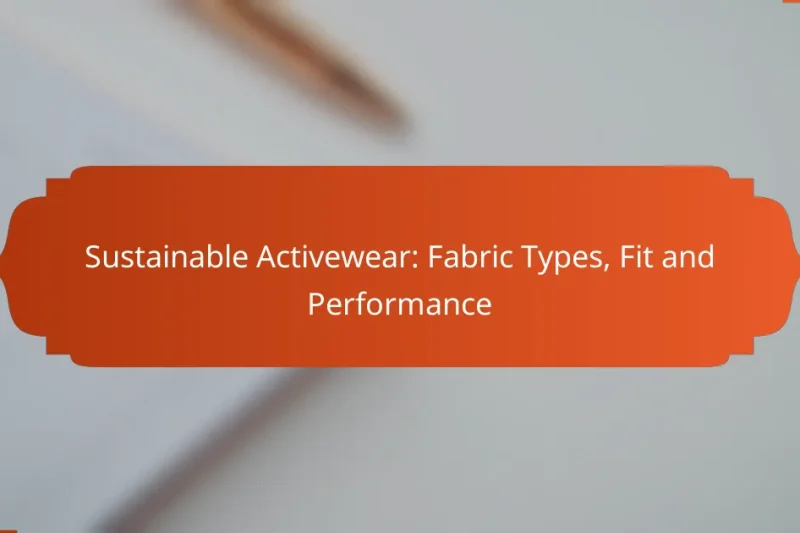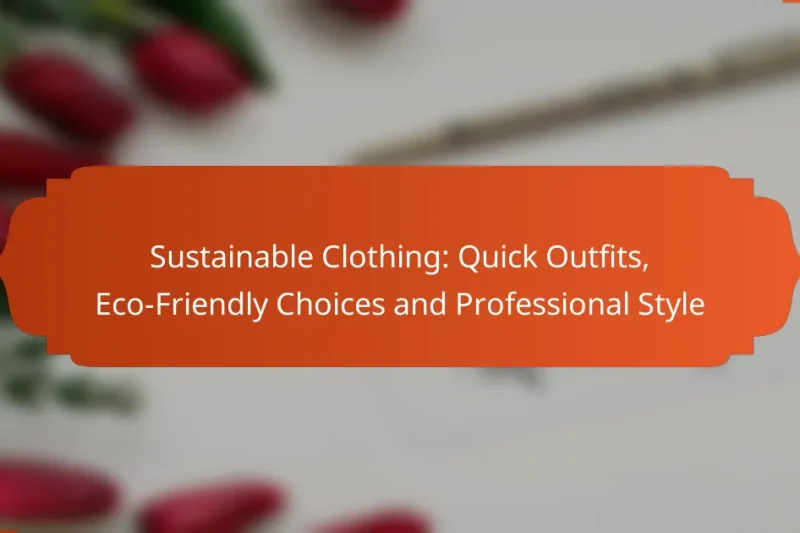In today’s world, parents can embrace sustainable fashion without breaking the bank by exploring budget-friendly options … Sustainable Fashion: Budget-Friendly Options for ParentsRead more
Sustainable Fashion for Every Lifestyle
Sustainable fashion offers a stylish and responsible choice for individuals seeking to align their wardrobe with eco-friendly values. By focusing on ethical production and versatile designs, it caters to diverse lifestyles while supporting local economies. Embracing brands that prioritize sustainability can lead to a more conscious and impactful approach to personal style.
Sustainable Fashion: Minimalist Integration, Key Pieces and Essentials
Sustainable fashion through a minimalist lens emphasizes the importance of selecting versatile, high-quality pieces that contribute … Sustainable Fashion: Minimalist Integration, Key Pieces and EssentialsRead more
Sustainable Clothing: Travel Packing Tips, Eco-Conscious Choices and Versatile Styles
Packing sustainable clothing for travel is essential for minimizing your environmental impact while ensuring versatility and … Sustainable Clothing: Travel Packing Tips, Eco-Conscious Choices and Versatile StylesRead more
Sustainable Activewear: Fabric Types, Fit and Performance
Sustainable activewear combines eco-friendly materials with high performance, making it an ideal choice for environmentally conscious … Sustainable Activewear: Fabric Types, Fit and PerformanceRead more
Sustainable Clothing: Quick Outfits, Eco-Friendly Choices and Professional Style
Sustainable clothing provides a stylish solution for those seeking quick outfits while prioritizing eco-friendly choices. By … Sustainable Clothing: Quick Outfits, Eco-Friendly Choices and Professional StyleRead more
Eco-Friendly Fashion: Plus-Size Options, Style Tips and Comfort
Eco-friendly fashion is making strides in the plus-size market, offering stylish and sustainable options that cater … Eco-Friendly Fashion: Plus-Size Options, Style Tips and ComfortRead more
How can sustainable fashion fit into urban lifestyles?
Sustainable fashion can seamlessly integrate into urban lifestyles by prioritizing eco-friendly materials, ethical production, and versatile designs. Urban dwellers can choose clothing that not only reflects their personal style but also supports environmental sustainability and local economies.
Eco-friendly brands in urban areas
Many eco-friendly brands have emerged in urban settings, offering stylish options made from sustainable materials like organic cotton, recycled fabrics, and natural dyes. Brands such as Reformation, Everlane, and Patagonia have flagship stores in major cities, making it easier for consumers to access sustainable choices.
Additionally, local boutiques often carry curated selections from sustainable designers, allowing shoppers to support small businesses while making environmentally conscious purchases. Look for brands that are transparent about their supply chains and production practices.
Versatile clothing for city living
Versatile clothing is essential for urban living, where individuals often transition between work, social events, and leisure activities. Key pieces include adaptable items like a tailored blazer that can be dressed up or down, or multifunctional dresses that work for both day and night.
When selecting versatile clothing, consider items that can be layered or mixed and matched. Neutral colors and classic styles tend to offer more flexibility, allowing for a variety of outfits without needing a large wardrobe.
Local sustainable fashion events
Urban areas frequently host sustainable fashion events, such as pop-up shops, swap meets, and eco-fashion shows. These events provide opportunities to discover local designers, learn about sustainable practices, and connect with like-minded individuals.
Check community boards, social media, or local fashion organizations for upcoming events. Participating in these gatherings can enhance your understanding of sustainable fashion and help you make informed choices in your wardrobe.
What are the best sustainable fashion brands?
Some of the best sustainable fashion brands include Patagonia, Eileen Fisher, and Reformation. These companies prioritize eco-friendly materials, ethical labor practices, and innovative designs that reduce environmental impact.
Patagonia’s commitment to sustainability
Patagonia is renowned for its strong commitment to sustainability, focusing on using recycled materials and organic cotton in its products. The brand also promotes fair labor practices and transparency in its supply chain, ensuring that workers are treated ethically.
Additionally, Patagonia encourages customers to repair and recycle their clothing through initiatives like the Worn Wear program, which helps extend the life of garments and reduce waste.
Eileen Fisher’s circular design model
Eileen Fisher embraces a circular design model that emphasizes sustainability throughout the product lifecycle. The brand creates timeless pieces using organic and sustainable fabrics, aiming to minimize waste and environmental impact.
Through its Renew program, Eileen Fisher takes back worn garments for resale or recycling, promoting a circular economy and encouraging consumers to participate in sustainable fashion practices.
Reformation’s eco-conscious collections
Reformation is known for its eco-conscious collections that blend style with sustainability. The brand uses sustainable materials and practices, such as water-efficient production processes and carbon-neutral shipping.
Reformation also provides transparency by sharing detailed information about the environmental impact of each product, helping consumers make informed choices that align with their values.
How to choose sustainable materials?
Choosing sustainable materials involves selecting fabrics that minimize environmental impact and promote ethical production practices. Look for certifications like GOTS for organic textiles or OEKO-TEX for non-toxic materials, and consider the lifecycle of the fabric from production to disposal.
Organic cotton vs conventional cotton
Organic cotton is grown without synthetic pesticides and fertilizers, making it a healthier choice for the environment and farmers. In contrast, conventional cotton often relies on harmful chemicals that can degrade soil and water quality.
When selecting between organic and conventional cotton, consider the benefits of organic farming practices, such as improved biodiversity and reduced water usage. Although organic cotton may be slightly more expensive, the long-term environmental benefits often justify the cost.
Benefits of Tencel and hemp
Tencel, made from sustainably sourced wood pulp, is known for its softness and moisture-wicking properties. It is biodegradable and produced in a closed-loop process that recycles water and solvents, reducing waste.
Hemp is another sustainable option, requiring minimal water and no pesticides to grow. It is durable and can be used in various products, from clothing to accessories, making it a versatile choice for eco-conscious consumers.
Recycled polyester in fashion
Recycled polyester is made from post-consumer plastic waste, such as bottles, reducing the need for virgin materials and lowering carbon emissions. This fabric is commonly used in activewear and outerwear, offering durability and moisture management.
When considering recycled polyester, check for certifications like Global Recycled Standard (GRS) to ensure the material meets sustainability criteria. While it may not be as biodegradable as natural fibers, its use helps divert plastic from landfills and oceans.
What are the pricing strategies for sustainable fashion?
Sustainable fashion pricing strategies often reflect the higher costs associated with ethical production, quality materials, and fair labor practices. Brands typically balance these costs with consumer demand for eco-friendly products, leading to a range of pricing models.
Cost comparison with fast fashion
When comparing sustainable fashion to fast fashion, prices for sustainable items are generally higher due to the ethical sourcing and production processes involved. Fast fashion brands often rely on low-cost materials and labor, resulting in lower prices but potentially compromising quality and environmental impact.
For example, a sustainable shirt may cost between $30 to $100, while a similar fast fashion shirt might range from $10 to $30. This difference reflects the investment in sustainable practices and quality craftsmanship.
Value of investment in quality
Investing in sustainable fashion often means purchasing higher-quality items that last longer, reducing the need for frequent replacements. This approach can lead to cost savings over time, as consumers may buy fewer pieces that withstand wear and tear.
Additionally, sustainable garments often feature timeless designs, making them versatile and suitable for various occasions. This longevity and adaptability enhance their overall value compared to cheaper, trend-driven fast fashion items.
Discounts and sales on sustainable brands
Sustainable brands frequently offer discounts and sales to make their products more accessible. These promotions can include seasonal sales, clearance events, or special offers for loyal customers.
Shoppers can also find sustainable fashion at reduced prices through online marketplaces or second-hand shops, where gently used items are available at lower costs. Taking advantage of these opportunities can help consumers build a sustainable wardrobe without overspending.
How to care for sustainable clothing?
Caring for sustainable clothing involves practices that extend the life of garments while minimizing environmental impact. This includes proper washing, repairing instead of replacing, and following specific guidelines to maintain fabric integrity.
Washing tips for longevity
To ensure the longevity of sustainable clothing, wash items in cold water and choose a gentle cycle. This reduces energy consumption and helps preserve fabric quality. Avoid using harsh detergents; instead, opt for eco-friendly alternatives that are biodegradable.
Limit washing frequency by airing out clothes between wears and spot cleaning when necessary. When drying, air-drying is preferable to machine drying, as it prevents shrinkage and maintains the garment’s shape.
Repairing vs replacing garments
Repairing garments is often more sustainable than replacing them, as it reduces waste and conserves resources. Simple repairs like sewing buttons or fixing seams can significantly extend a garment’s life. Many communities offer workshops or resources for learning basic repair skills.
Consider the condition of the garment before deciding to replace it. If the fabric is still in good shape but has minor damage, repairing is usually the better option. However, if a garment is beyond repair, recycling or donating it can help mitigate environmental impact.





